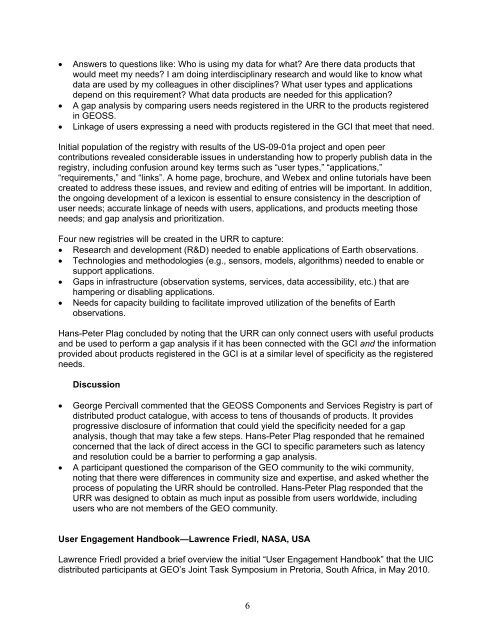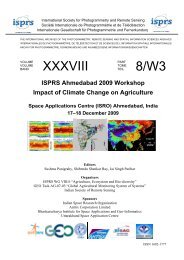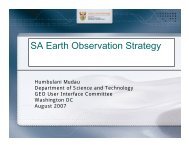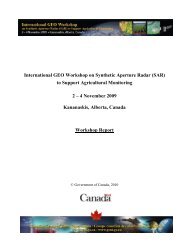GEO UIC Committee: - Group on Earth Observations
GEO UIC Committee: - Group on Earth Observations
GEO UIC Committee: - Group on Earth Observations
You also want an ePaper? Increase the reach of your titles
YUMPU automatically turns print PDFs into web optimized ePapers that Google loves.
• Answers to questi<strong>on</strong>s like: Who is using my data for what? Are there data products that<br />
would meet my needs? I am doing interdisciplinary research and would like to know what<br />
data are used by my colleagues in other disciplines? What user types and applicati<strong>on</strong>s<br />
depend <strong>on</strong> this requirement? What data products are needed for this applicati<strong>on</strong>?<br />
• A gap analysis by comparing users needs registered in the URR to the products registered<br />
in <str<strong>on</strong>g>GEO</str<strong>on</strong>g>SS.<br />
• Linkage of users expressing a need with products registered in the GCI that meet that need.<br />
Initial populati<strong>on</strong> of the registry with results of the US-09-01a project and open peer<br />
c<strong>on</strong>tributi<strong>on</strong>s revealed c<strong>on</strong>siderable issues in understanding how to properly publish data in the<br />
registry, including c<strong>on</strong>fusi<strong>on</strong> around key terms such as “user types,” “applicati<strong>on</strong>s,”<br />
“requirements,” and “links”. A home page, brochure, and Webex and <strong>on</strong>line tutorials have been<br />
created to address these issues, and review and editing of entries will be important. In additi<strong>on</strong>,<br />
the <strong>on</strong>going development of a lexic<strong>on</strong> is essential to ensure c<strong>on</strong>sistency in the descripti<strong>on</strong> of<br />
user needs; accurate linkage of needs with users, applicati<strong>on</strong>s, and products meeting those<br />
needs; and gap analysis and prioritizati<strong>on</strong>.<br />
Four new registries will be created in the URR to capture:<br />
• Research and development (R&D) needed to enable applicati<strong>on</strong>s of <strong>Earth</strong> observati<strong>on</strong>s.<br />
• Technologies and methodologies (e.g., sensors, models, algorithms) needed to enable or<br />
support applicati<strong>on</strong>s.<br />
• Gaps in infrastructure (observati<strong>on</strong> systems, services, data accessibility, etc.) that are<br />
hampering or disabling applicati<strong>on</strong>s.<br />
• Needs for capacity building to facilitate improved utilizati<strong>on</strong> of the benefits of <strong>Earth</strong><br />
observati<strong>on</strong>s.<br />
Hans-Peter Plag c<strong>on</strong>cluded by noting that the URR can <strong>on</strong>ly c<strong>on</strong>nect users with useful products<br />
and be used to perform a gap analysis if it has been c<strong>on</strong>nected with the GCI and the informati<strong>on</strong><br />
provided about products registered in the GCI is at a similar level of specificity as the registered<br />
needs.<br />
Discussi<strong>on</strong><br />
• George Percivall commented that the <str<strong>on</strong>g>GEO</str<strong>on</strong>g>SS Comp<strong>on</strong>ents and Services Registry is part of<br />
distributed product catalogue, with access to tens of thousands of products. It provides<br />
progressive disclosure of informati<strong>on</strong> that could yield the specificity needed for a gap<br />
analysis, though that may take a few steps. Hans-Peter Plag resp<strong>on</strong>ded that he remained<br />
c<strong>on</strong>cerned that the lack of direct access in the GCI to specific parameters such as latency<br />
and resoluti<strong>on</strong> could be a barrier to performing a gap analysis.<br />
• A participant questi<strong>on</strong>ed the comparis<strong>on</strong> of the <str<strong>on</strong>g>GEO</str<strong>on</strong>g> community to the wiki community,<br />
noting that there were differences in community size and expertise, and asked whether the<br />
process of populating the URR should be c<strong>on</strong>trolled. Hans-Peter Plag resp<strong>on</strong>ded that the<br />
URR was designed to obtain as much input as possible from users worldwide, including<br />
users who are not members of the <str<strong>on</strong>g>GEO</str<strong>on</strong>g> community.<br />
User Engagement Handbook—Lawrence Friedl, NASA, USA<br />
Lawrence Friedl provided a brief overview the initial “User Engagement Handbook” that the <str<strong>on</strong>g>UIC</str<strong>on</strong>g><br />
distributed participants at <str<strong>on</strong>g>GEO</str<strong>on</strong>g>’s Joint Task Symposium in Pretoria, South Africa, in May 2010.<br />
6







